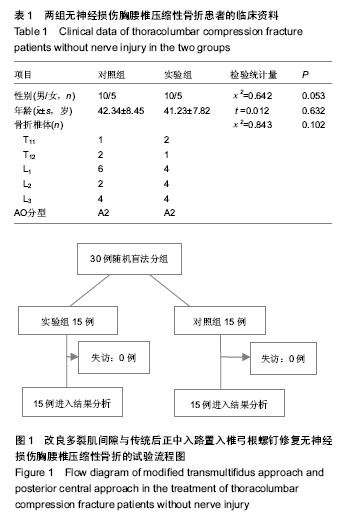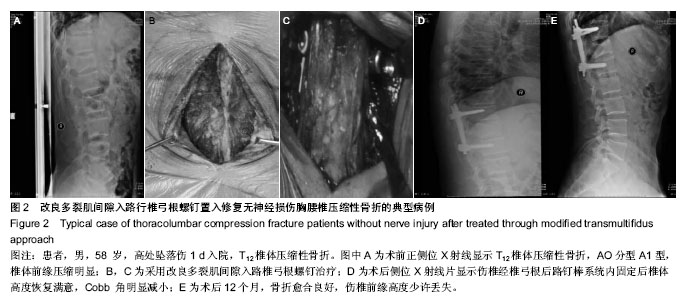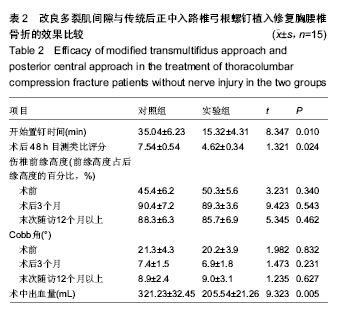| [1] Weber BR, Grob D, Dvorák J, et al. Posterior surgical approach to the lumbar spine and its effect on the multifidus muscle. Spine (Phila Pa 1976). 1997;22(15):1765-1772.
[2] Kim CW. Scientific basis of minimally invasive spine surgery: prevention of multifidus muscle injury during posterior lumbar surgery. Spine (Phila Pa 1976). 2010;35 (26 Suppl): S281-286.
[3] Hoh DJ, Wang MY, Ritland SL. Anatomic features of the paramedian muscle-splitting approaches to the lumbar spine. Neurosurgery. 2010;66(3 Suppl Operative):13-25.
[4] Hu ZJ, Fang XQ, Fan SW. Iatrogenic injury to the erector spinae during posterior lumbar spine surgery: underlying anatomical considerations, preventable root causes, and surgical tips and tricks. Eur J Orthop Surg Traumatol. 2014; 24(2):127-135.
[5] Kalimo H, Rantanen J, Viljanen T, et al. Lumbar muscles: structure and function. Ann Med. 1989;21(5):353-359.
[6] Zanoli G. Outcome assessment in lumbar spine surgery. Acta Orthop Suppl. 2005;76(318):5-47.
[7] 宓士军,刘长林,郑智慧,等.经皮椎弓根内固定联合椎体成形术治疗骨质疏松椎体压缩骨折[J].中国骨与关节损伤杂志,2011, 26(1): 59-60.
[8] Wiltse LL, Spencer CW. New uses and refinements of the paraspinal approach to the lumbar spine. Spine (Phila Pa 1976). 1988;13(6):696-706.
[9] McCulloch JA, Weiner BK. Microsurgery in the lumbar intertransverse interval. Instr Course Lect. 2002;51:233-241.
[10] Grifka J, Witte H, Faustmann P, et al. Surgical approach in lumbar intervertebral disk displacement. Topographical principles and characteristics. Orthopade. 1999;28(7): 572-578.
[11] Palmer DK, Allen JL, Williams PA, et al. Multilevel magnetic resonance imaging analysis of multifidus-longissimus cleavage planes in the lumbar spine and potential clinical applications to Wiltse's paraspinal approach. Spine (Phila Pa 1976). 2011;36(16):1263-1267.
[12] Edwards CC 2nd, Bridwell KH, Patel A, et al. Long adult deformity fusions to L5 and the sacrum. A matched cohort analysis. Spine (Phila Pa 1976). 2004;29(18):1996-2005.
[13] Hebert JJ, Marcus RL, Koppenhaver SL, et al. Postoperative rehabilitation following lumbar discectomy with quantification of trunk muscle morphology and function:a case report and review of the literature.J Orthop Sports Phys Ther. 2010; 40(7):402-412.
[14] 罗肖,陈敬忠,张怀学.经皮球囊扩充椎体成型术治疗无神经损伤胸腰椎骨折的临床观察[J].中国现代医药杂志,2013,15(7): 21-23.
[15] Fukui M, Chiba K, Kawakami M, et al. Japanese Orthopaedic Association Back Pain Evaluation Questionnaire. Part 2. Verification of its reliability : The Subcommittee on Low Back Pain and Cervical Myelopathy Evaluation of the Clinical Outcome Committee of the Japanese Orthopaedic Association. J Orthop Sci. 2007;12(6):526-532.
[16] Longo UG, Loppini M, Denaro L, et al. Rating scales for low back pain. Br Med Bull. 2010;94:81-144.
[17] Müller U, Duetz MS, Roeder C, et al. Condition-specific outcome measures for low back pain. Part I: validation. Eur Spine J. 2004;13(4):301-313.
[18] Müller U, Roeder C, Dubs L, et al. Condition-specific outcome measures for low back pain. Part II: scale construction. Eur Spine J. 2004;13(4):314-324.
[19] Kim DY, Lee SH, Chung SK, et al. Comparison of multifidus muscle atrophy and trunk extension muscle strength: percutaneous versus open pedicle screw fixation. Spine (Phila Pa 1976). 2005;30(1):123-129.
[20] Mobbs RJ, Sivabalan P, Li J. Technique, challenges and indications for percutaneous pedicle screw fixation. J Clin Neurosci. 2011;18(6):741-749.
[21] Weinstein JN, Rydevik BL, Rauschning W. Anatomic and technical considerations of pedicle screw fixation. Clin Orthop Relat Res. 1992;(284):34-46.
[22] Palmisani M, Gasbarrini A, Brodano GB, et al. Minimally invasive percutaneous fixation in the treatment of thoracic and lumbar spine fractures. Eur Spine J. 2009;18 Suppl 1:71-74.
[23] Parker JW, Lane JR, Karaikovic EE, et al. Successful short-segment instrumentation and fusion for thoracolumbar spine fractures: a consecutive 41/2-year series. Spine (Phila Pa 1976). 2000;25(9):1157-1170.
[24] Knop C, Blauth M, Bastian L, et al. Fractures of the thoracolumbar spine. Late results of dorsal instrumentation and its consequences. Unfallchirurg. 1997;100(8):630-639.
[25] Liu Y, Yin Q, Gu S, et al. Research progress of stress fracture of lumbar pedicle. Zhongguo Xiu Fu Chong Jian Wai Ke Za Zhi. 2013;27(2):240-242.
[26] Rutherford EE, Tarplett LJ, Davies EM, et al. Lumbar spine fusion and stabilization: hardware, techniques, and imaging appearances. Radiographics. 2007;27(6):1737-1749.
[27] Ha AS, Petscavage-Thomas JM. Imaging of current spinal hardware: lumbar spine. AJR Am J Roentgenol. 2014;203(3): 573-581.
[28] Spena G, Panciani PP, Costi E, et al. Minimally invasive surgery for thoracic and lumbar spinal fractures: rationale for treatment. J Neurosurg Sci. 2014;58(2 Suppl 1):23-27.
[29] Wild MH, Glees M, Plieschnegger C, et al. Five-year follow-up examination after purely minimally invasive posterior stabilization of thoracolumbar fractures: a comparison of minimally invasive percutaneously and conventionally open treated patients. Arch Orthop Trauma Surg. 2007;127(5): 335-343.
[30] Knop C, Bastian L, Lange U, et al. Transpedicular fusion of the thoraco-lumbar junction. Clinical, radiographic and CT results. Orthopade. 1999;28(8):703-713.
[31] Korovessis P, Repantis T, Iliopoulos P, et al. Beneficial influence of titanium mesh cage on infection healing and spinal reconstruction in hematogenous septic spondylitis: a retrospective analysis of surgical outcome of twenty-five consecutive cases and review of literature. Spine (Phila Pa 1976). 2008;33(21):E759-767.
[32] Hakalo J, Wroński J. Complications of a transpedicular stabilization of thoraco-lumbar burst fractures. Neurol Neurochir Pol. 2006;40(2):134-139.
[33] Pizanis A, Mutschler W. Dorsal stabilization of fractures of the thoracic and lumbar spine by external fixator--technique and outcome. Zentralbl Chir. 1998;123(8):936-943.
[34] Bellabarba C, Fisher C, Chapman JR, et al. Does early fracture fixation of thoracolumbar spine fractures decrease morbidity or mortality? Spine (Phila Pa 1976). 2010;35(9 Suppl):S138-145.
[35] Court C, Vincent C. Percutaneous fixation of thoracolumbar fractures: current concepts. Orthop Traumatol Surg Res. 2012;98(8):900-909.
[36] Peng J, Xu J. Research progress in surgical treatment of thoracolumbar fracture. Zhongguo Xiu Fu Chong Jian Wai Ke Za Zhi. 2009;23(12):1506-1509.
[37] Amini A, Beisse R, Schmidt MH. Thoracoscopic spine surgery for decompression and stabilization of the anterolateral thoracolumbar spine. Neurosurg Focus. 2005;19(6):E4.
[38] Rampersaud YR, Annand N, Dekutoski MB. Use of minimally invasive surgical techniques in the management of thoracolumbar trauma: current concepts. Spine (Phila Pa 1976). 2006;31(11 Suppl):S96-102; discussion S104.
[39] Vaccaro AR. Combined anterior and posterior surgery for fractures of the thoracolumbar spine. Instr Course Lect. 1999; 48:443-449.
[40] Oner FC, Dhert WJ, Verlaan JJ. Less invasive anterior column reconstruction in thoracolumbar fractures. Injury. 2005; 36 Suppl 2:B82-89.
[41] Kim DH, Jaikumar S, Kam AC. Minimally invasive spine instrumentation. Neurosurgery. 2002;51(5 Suppl):S15-25.
[42] 胡庆丰,范顺武,潘浩,等.肌间隙入路椎弓根钉固定结合椎体成形术治疗胸腰椎骨折[J].中国中西医结合外科杂志,2010, 16(1): 5-9.
[43] 汪学军,李开南,母建松,等.椎间盘镜下椎弓根螺钉内固定治疗胸腰椎骨折[J].中国矫形外科杂志,2007,15(4):316-317.
[44] 张强,纪玉清,胡樵,等.胸腰椎骨折后路微创器械的设计及临床应用[J].中华创伤骨科杂志,2010,1212(7):605-608.
[45] 王景续,杨冬,郭勇,等.经椎弓根植骨技术治疗胸腰椎骨折[J].中国临床医学,2007,14(2):238-239.
[46] 国家中医药管理局.中医病症诊断疗效标准[M].南京:南京大学出版社,1994:176.
[47] 陈宣煌,许卫红,胡建伟,等.小切口椎旁肌间隙入路和传统开放式入路腰椎后路融合术的比较[J].脊柱外科杂志,2012,4(2): 101-104.
[48] 侯树勋.现代创伤骨科学[M].北京:人民军医出版社,2002: 950-988.
[49] 那孟奇. Wiltse肌间隙入路与传统后正中入路在治疗胸腰段骨折的比较研究[J].右江民族医学院院报,2011,33(2):145-147.
[50] 邓万祥,赵胡瑞,刘华,等.经伤椎置钉治疗胸腰椎骨折的临床研究[J].中国骨伤,2011,24(7):541-543.
[51] Vialle R, Wicart P, Drain O, et al. The Wiltse paraspinal approach to the lumbar spine revisited: an anatomic study. Clin Orthop Relat Res. 2006;445:175-180.
[52] Gazzeri R, Tamorri M, Galarza M, et al. Balloon-assisted endoscopic retroperitoneal gasless approach (BERG) for lumbar interbody fusion: is it a valid alternative to the laparoscopic approach? Minim Invasive Neurosurg. 2007; 50(3):150-154.
[53] MacDonald DA, Moseley GL, Hodges PW. The lumbar multifidus: does the evidence support clinical beliefs? Man Ther. 2006;11(4):254-263.
[54] Warren A, Prasad V, Thomas M. Pre-operative planning when using the Wiltse approach to the lumbar spine. Ann R Coll Surg Engl. 2010;92(1):74-75. |


